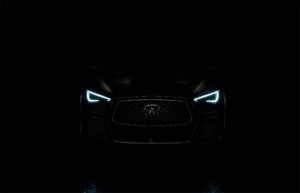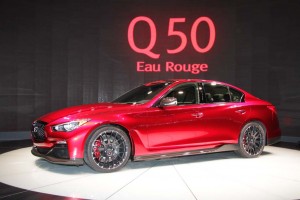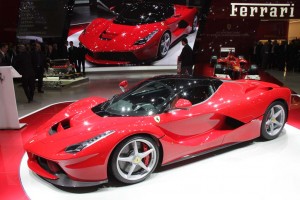Infiniti is going from red to black – not on the bottom line but on the street.
It plans to introduce what it is describing as a “radical reinterpretation” of its Q60 coupe at the Geneva Motor Show next week, a vehicle that marks the debut of what it calls “Project Black S,” an “exploration” of a new high-performance brand-within-a-brand.
While Nissan’s luxury marque isn’t tipping its hat much in advance of the Swiss car show, Project Black S appears to be a reincarnation of another high-performance sub-brand project Infiniti had explored a few years ago, called Eau Rouge. But it will take a very different approach under the hood.
(Battery-carmakers compete for “world’s fastest crown. Click Here for the story.)
The maker has been rapidly expanding its line-up in recent years, as it moves to expand from a largely U.S.-focused niche player to a truly global, Tier One luxury brand. That includes several more sporty offerings. But it lags key rivals who have launched distinct performance nameplates, such as BMW’s M and Mercedes’ AMG.
“Infiniti is the premium car manufacturer within the Renault-Nissan Alliance, and a technical partner to the Renault Sport Formula One Team, so it is natural that we come together to explore the possibility of bringing innovative high-performance hybrid technology to our customers,” said Infiniti President Roland Krueger, in a news release teasing the debut of the Project Black S project in Geneva.
Among the few details Infiniti is offering up, it hints that the modified Q60 coupe will feature a much more aerodynamic design, as well as a “unique-for-the-road hybrid powertrain.”
“The performance hybrid powertrain being explored through Project Black S features an ‘energy recovery system’ (ERS) to harvest energy, deploying recovered electric power to boost power and torque,” Infiniti explains. “The result is instant, significant, lag-free acceleration. Inspired by the dual-hybrid system proven in Formula One, the technology does not yet exist in a current road car.”
Exactly how closely the energy recovery system will mirror KERS, or Kinetic Energy Recovery System, used in Formula One vehicles isn’t clear. But other manufacturers have also turned to Formula One for help in a similar vein. That includes Ferrari, with the LaFerrari hypercar, as well as McLaren, with its P1.
Indeed, a growing number of high-line automakers have been turning to electrified powertrains to boost performance while also maintaining some semblance of reasonable fuel economy. Porsche’s top performing 918 Spyder was a good example, using a plug-in hybrid system to produce a neck-snapping 887 horsepower.
Electric motors have the advantage of delivering instantaneous torque, rather than having to wait for RPMs to build, as is the case with conventional turbochargers.
Tesla’s Model S sedan, using the optional Ludicrous Mode, is now the world’s fastest production vehicle off the line, hitting 60 in around 2.8 seconds. A prototype of the planned Faraday Future FF91 cut that to just under 2.4 seconds in recent testing.
Even more mainstream brands are looking at electrified options for performance models, Ford recently confirming plans to build a hybrid-powered Mustang.
There are drawbacks, however, including cost, as well as the need to carry around heavy batteries that, among other things, impact cornering and handling.
(Click Here to check out the two new models Infiniti debuted at the Chicago Auto Show.)
We’ll learn more about how Infiniti plans to address the challenges of a hybrid performance car at Geneva’s PALExpo convention center on March 6th.
Infiniti is not committing to launch the new sub-brand, saying only that the Project Black S concept vehicle will “help to gauge potential public interest in high-performance derivatives.”
But it seems clear that the Nissan subsidiary wants to pick up on where it started to go with the Eau Rouge concept earlier in the decade. And going the hybrid route would give it a clear way to distinguish itself from other performance luxury sub-brands, such as Mercedes-AMG and BMW M.
(The growth of battery power will lead to radical changes in vehicle design. Click Hereto learn how.)



